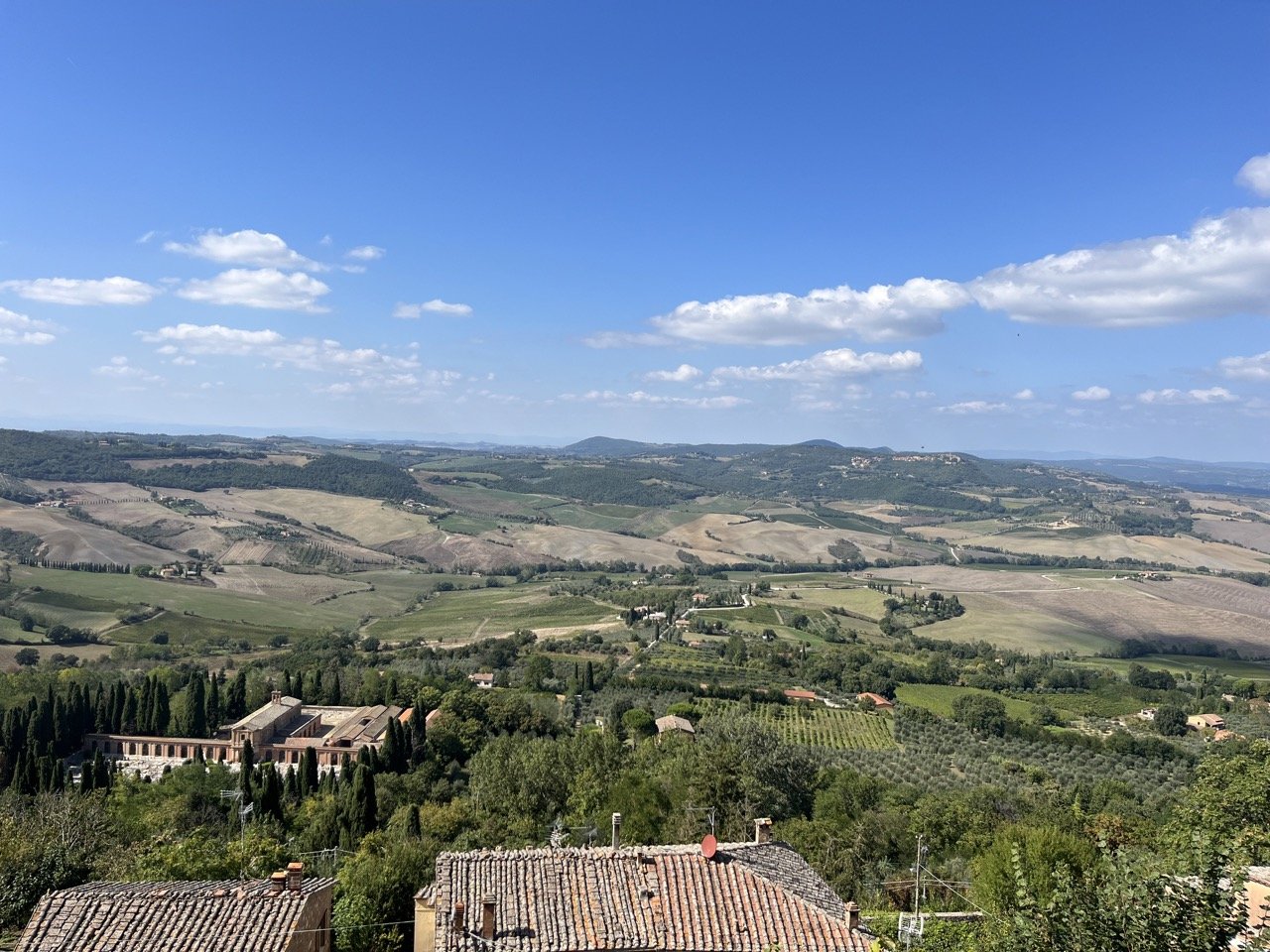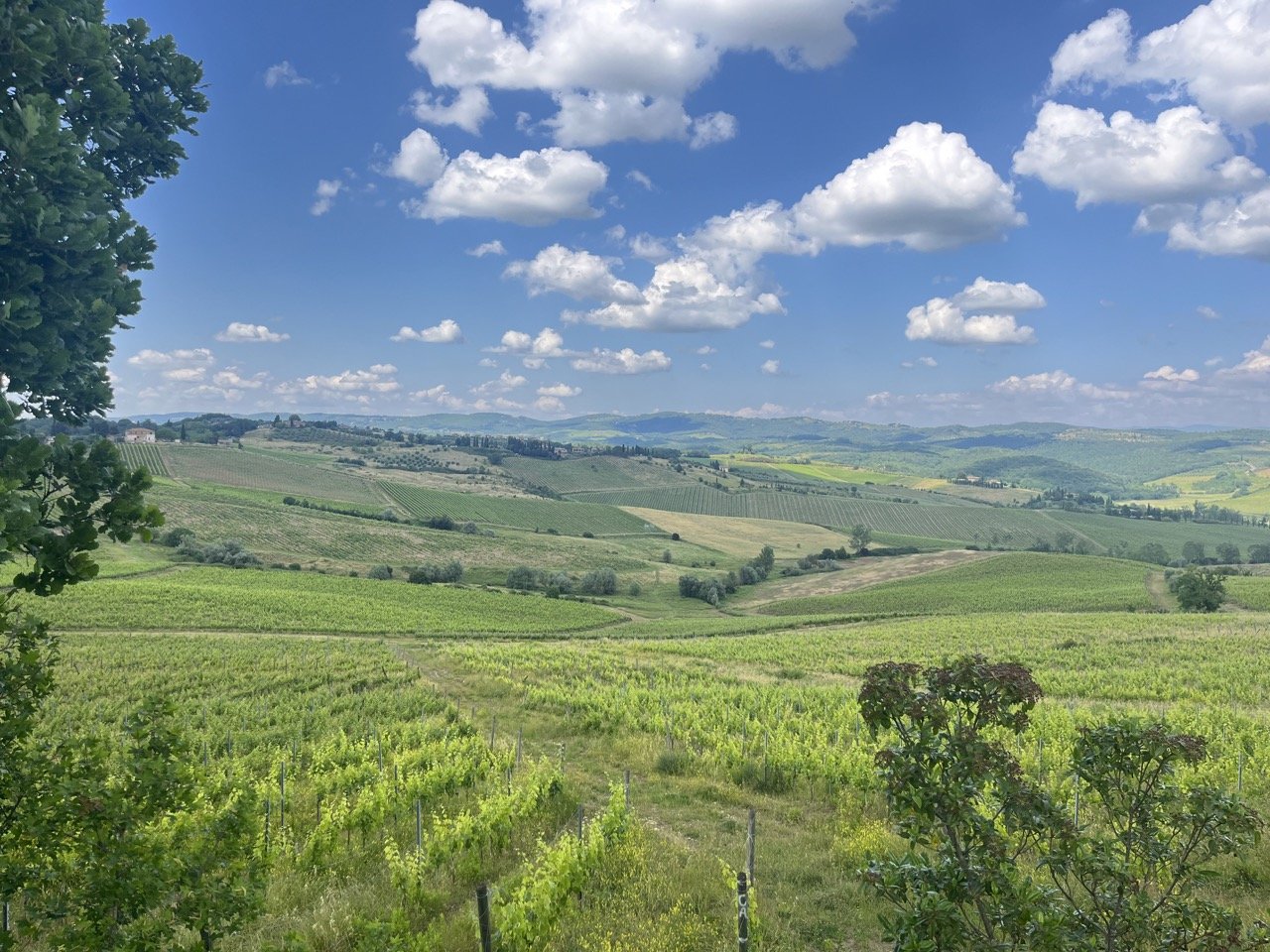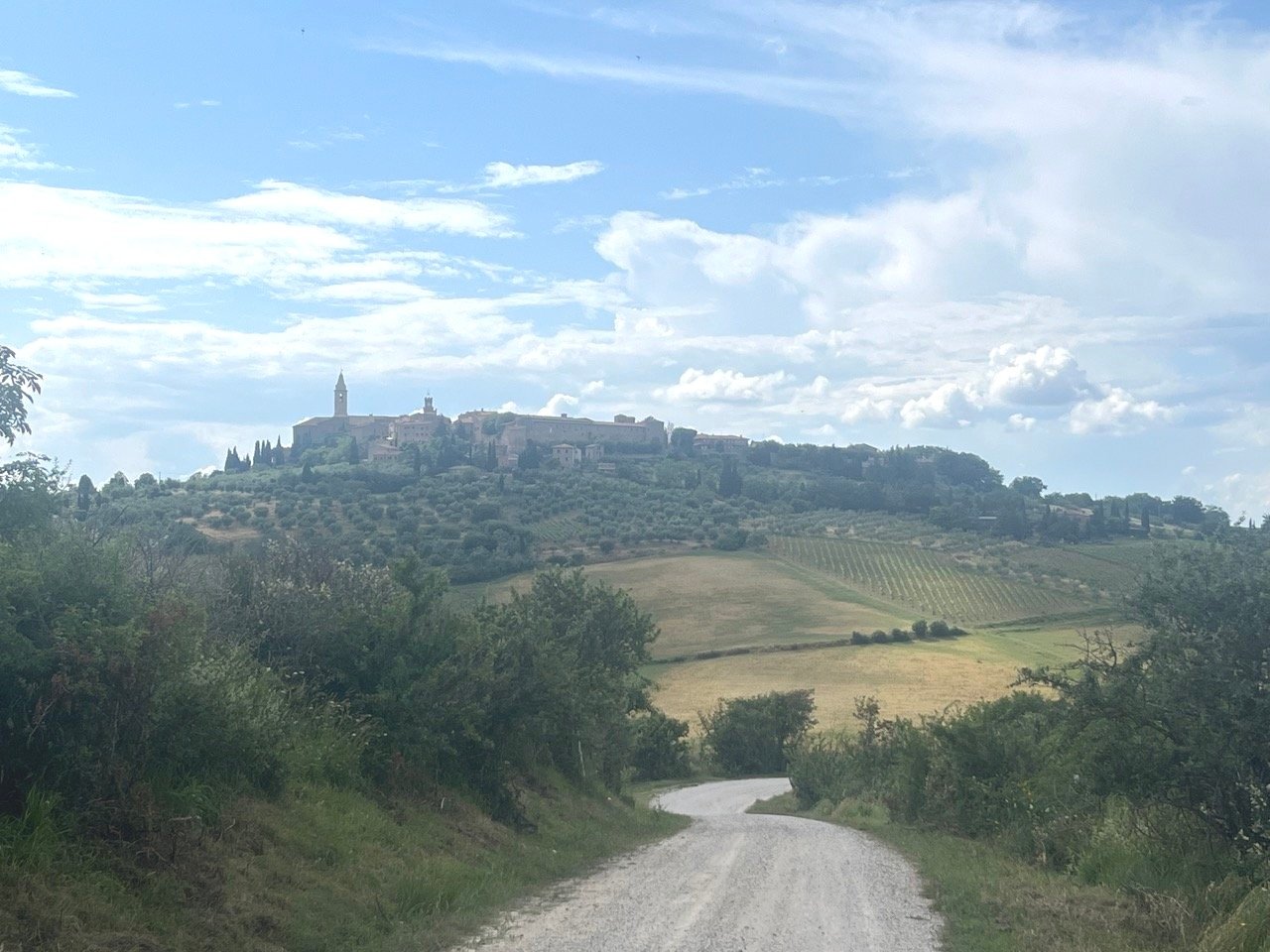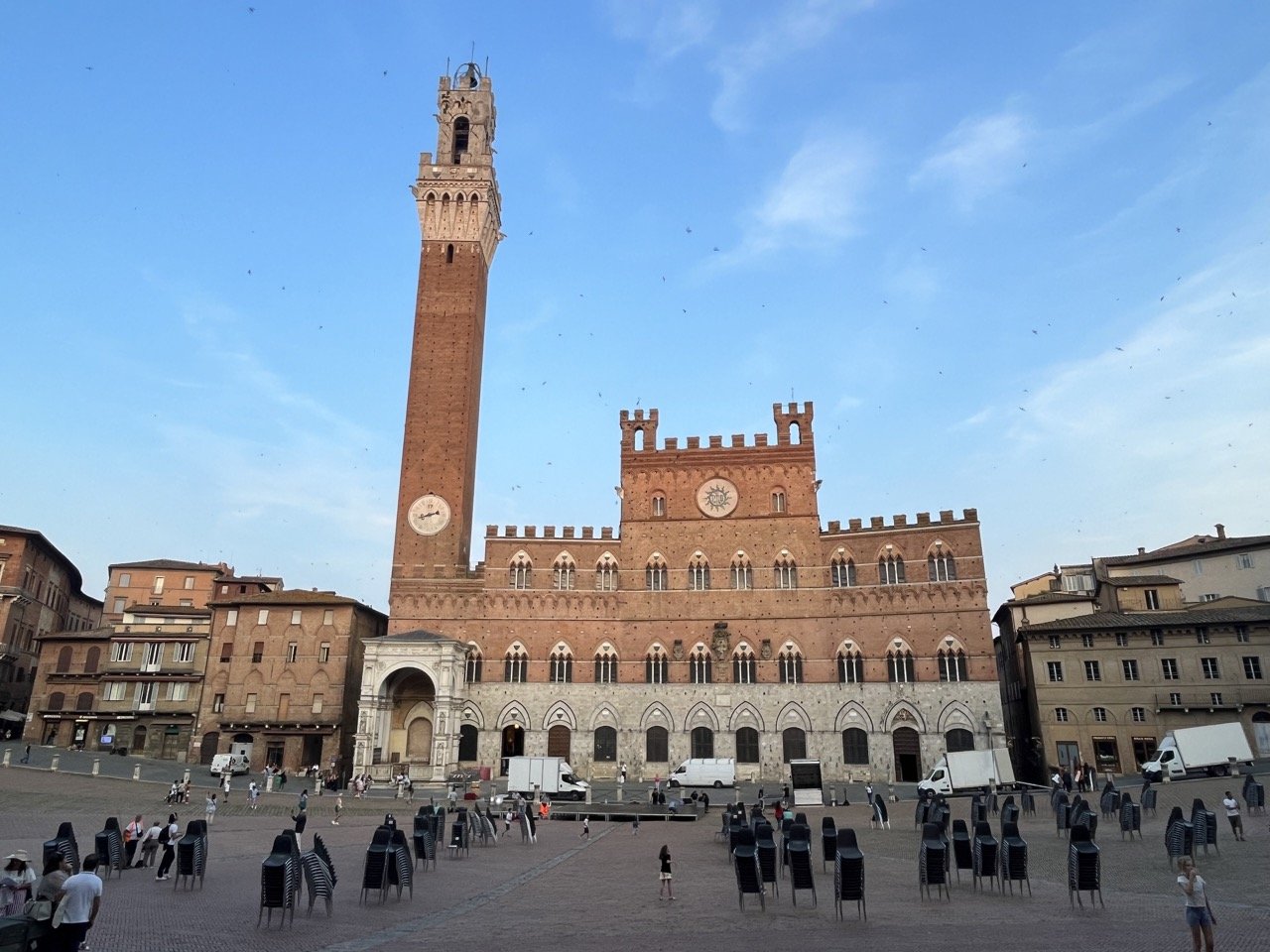Guide to Montepulciano, Italy
Affiliate disclosure: some of the links in this article are affiliate links. If you book using one of them, we’ll earn a small commission. All of our info is free to read and free of ads, so we appreciate it!
The loftiest of all the Tuscan hill towns, Montepulciano sits atop a volcanic ridge almost 2,000 feet above vineyard-carpeted valleys far below. Grapes have been earning the town notoriety since the 14th century, when it began producing reds that have evolved into two of Italy’s most acclaimed wines, Vino Nobile di Montepulciano and Rosso di Montepulciano.
One compelling reason to come to Montepulciano, of course, is to taste these wines at the source, in enotecas and cantinas on and off the main street that winds its way up to Piazza Grande at the top of the town.
You’ll work for your libation, though — it’s a steep uphill climb, but the medieval alleyways, Renaissance palaces, and friendly buzz of small town life along the way make it a pleasure to be here.
When it’s time to move on, the beautiful landscapes of the Val d’Orcia are just beyond the town gates, and Siena, Cortona, and many of Tuscany’s other great calling cards are just a short drive away.
Table of Contents
Tuscany planning cheatsheet
 Plan your itinerary with expert advice
Plan your itinerary with expert advice
- Book an Italy travel consultation with a local expert
 My favorite hotels in Tuscany
My favorite hotels in Tuscany
- Hotel Calimala - Gorgeous boutique hotel in Florence's historic center. $250-450 USD
- Locanda de Ciomp - Excellent value guesthouse in Florence. $150-200 USD
- Palazzo Ravizza - Lovely midrange option in Siena. $120-175 USD
- Castello di Fonterutoli - Delightful castle & winery resort in the Chianti countryside. $200-300 USD
- Meublé il Riccio - Historic property in the heart of Montepulciano. $160 USD
- La Casa Di Adelina - Charming B&B in the Val d'Orcia village of Montichiello. $130 USD
 Guided tours and activities
Guided tours and activities
 How to get around
How to get around
- Car rentals with DiscoverCars
- Train tickets from Trenitalia and Italo
- Bus routes via Autolinee Toscane, Sitabus, and Flixbus
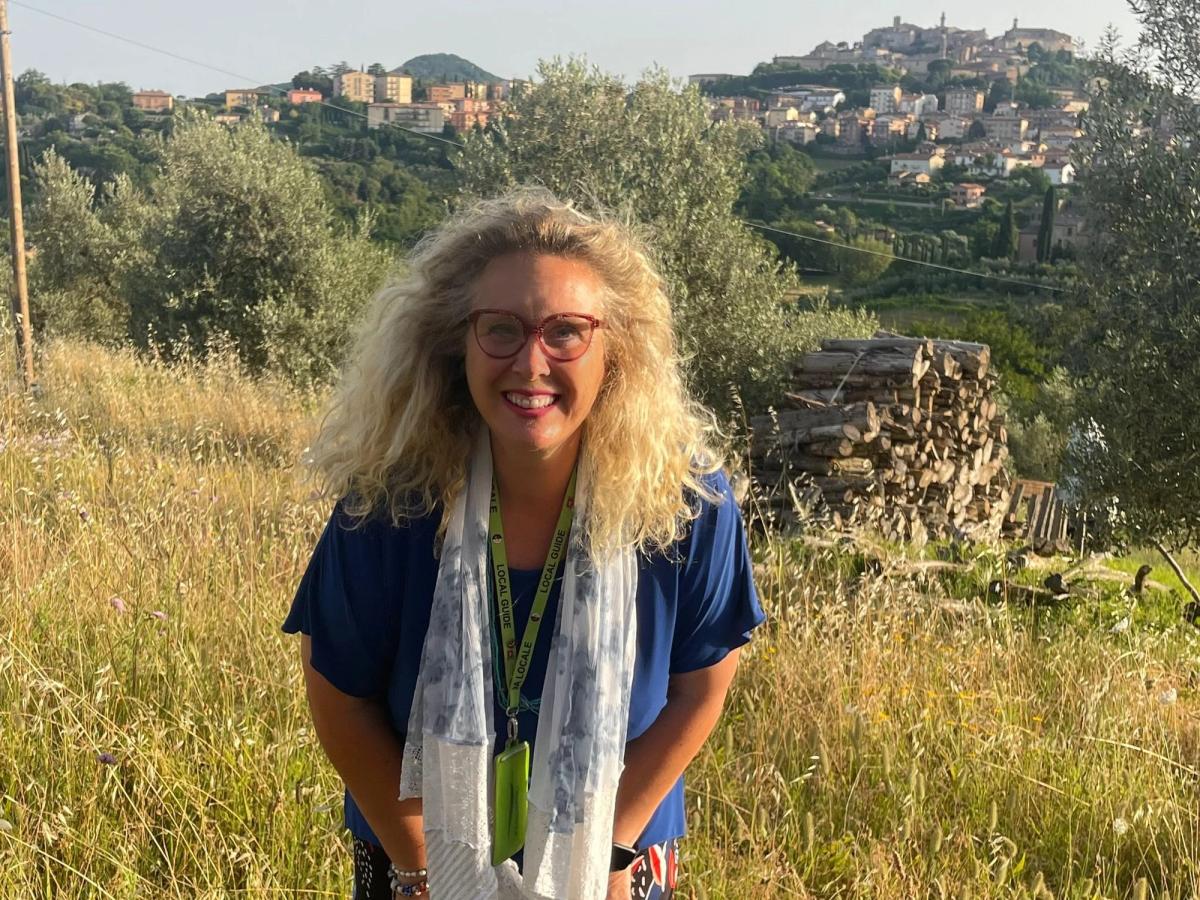

Where is Montepulciano?
Montepulciano is in southern Tuscany, 110km (68 miles) south of Florence. The medieval and Renaissance hill town sits atop a high ridge above two agricultural valleys, the Valdichiana and the Val d’Orcia.
The Val d’Orcia is quintessential Tuscany; all rolling fields of golden grains, terraced hills of vineyards, pretty hilltop towns, and expansive panoramas. The Valdichiana, on the other hand, is a lesser-known area and a more functioning agricultural one. All manner of vegetables are grown in the valley and the famous Chianina cattle (whose meat is used in Bistecca alla Fiorentina – Florentine steaks) is raised there.
How to get here
By public transport
The trip from Florence by train can be long (up to 3 hours) and usually involves at least one or two changes. The train station in Montepulciano is also a long way from town, in the valley about 9km (6 miles) to the east.
If coming from Rome, you’ll take the train about 2 hours to the town of Chiusi-Chianciano Terme where you’ll then need to switch to a different train (or a taxi) to get you the rest of the way to Montepulciano. Trains from Chiusi to Montepulciano run a few times per day.
Also know that public transport in Montepulciano (and the Val d’Orcia in general) is very poor and you won’t be able to do much if you’re relying on the train or bus. There are taxis in Montepulciano, but they can be hard to come by in the summer and fall and doing sightseeing with them is very expensive.
Many visitors also choose to stay in agriturismi (farm stays) and other rural accommodations outside of town, where a car is more or less essential.
By car
Coming from Florence, the drive to Montpeulciano is almost entirely done on the A1 autostrada (exit at Betolle-Valdichiana). It takes about an hour and a half. Realistically, you’ll want to have a car with you while here so that you can easily visit wineries, nearby towns, and scenic spots in the Val d’Orcia.
From Rome, it's about a 2-hour drive to Montepulciano, passing through the region of Lazio, a small slice of Umbria, and then Tuscany.
If you want to get a car close to Montepulciano, the closest place to go is the train station of Chiusi-Chianciano Terme (30 minutes away) where you have a few rental agencies.
To check prices and book, I recommend using DiscoverCars. It’s car rental website that includes offerings from all the major international rental companies as well as lots of smaller local agencies, which often have much better pricing. You can often find great deals.
Parking
Most of Montepulciano is closed to traffic, but paid parking areas ring the center. Be forewarned that in high season parking can be hard to find and some lots are unbelievably small and tight.
The lot by the Coop shopping center on the low side of town is usually the easiest place to park, but it does mean that your visit will involve mostly uphill walking.
Why visit
Montepulciano is a classic “Tuscan hilltop town”. It sits on a hill overlooking two lovely valleys on either side of it: the Valdichiana to the east and the Val d’Orcia to the west. This strategic location, and the bounty of the agricultural lands around it, has made it an important regional center since the Middle Ages.
Medieval in character, it has pretty architecture, a compact (albeit very hilly center) center, terrific viewpoints, and lots of good restaurants and wine bars. The town and surrounding vineyards produce an excellent local wine, Vino Nobile di Montepulciano.
It’s a pleasant place in its own right, but the main appeal of visiting is honestly that it’s a convenient stop on day trips and tours to the Val d’Orcia towns and wineries.
If you’re spending a few days in this part of Tuscany, it’s also good place to base yourself because it’s bigger than the other towns so has more going on (and more hotel options).
How long to spend
While you could rush through Montepulciano and see all the main sights in an hour or two, I think that 3-4 hours is the ideal amount of time to spend here.
A half day in Montepulciano gives you enough time to get a good sense of the town. With 3-4 hours, you'll be able have a look at Piazza Grande, stroll the main street of Via di Gracciano nel Corso, enjoy some of the city's good viewpoints, do some shopping, and have a meal or taste some wine
Anyone with even a passing interest in wine will want to spend some time underground in the labyrinthine wine cellars of Ercolani, Contucci, and other local cantinas that offer tours and tastings. Montepulciano also has many good restaurants, so it’s certainly worth having lunch or dinner in town.
If you want to visit a vineyard or two in addition to seeing the city, give yourself a full day. You could also easily spend half the day in Montepulciano and the other half exploring other towns like Pienza and Montichiello, for example.
Although the town itself can be visited in less than a day, many visitors choose to settle in for a couple days (and sometimes longer), taking day trips around the surrounding region and visiting nearby towns. Pienza, Montalcino, Montichiello, Bagno Vignoni, Cortona, and Siena are all within easy reach.
Where to stay
The rates below are for a double with breakfast and include a range from low-season (winter) to high-season. May and September and October are usually the most expensive times to stay.
Most of the hotels are in Montepulciano town itself, but some are in the surrounding countryside or the nearby towns of Pienza and Montichiello.
Palazzo Nobile di San Donato - An elegant Renaissance palace provides Montepulciano’s poshest accommodations, and the suites overlook Piazza Grande and the countryside below. From 300 euros to 400 euros.
L’Olmo – This elegantly renovated farmhouse with only 8 luxurious rooms sits 25 minutes from Montepulciano and just 10 from Pienza. It has a beautiful pool that offers sweeping views over the valley and Monte Amiata mountain on one side and Pienza on the other. Rooms start at around 350 euros per night.
La Bandita Townhouse - The most chic accommodations in Pienza (15 minutes to Montepulciano), and maybe all of the Val d’Orcia, are stylishly and comfortably decorated and have such luxuries as deep soaking tubs. Their restaurant is also superb. From 300 euros.
Agriturismo la Bruciata - Well-appointed apartments on a farm at the edge of the Val d’Orcia are set on beautiful grounds with two swimming pools and views that give you a sense of being in a beautiful landscape painting. From 600 euros to 1,000 euros a week.
Meublé il Riccio - The Caroti family houses guests in style and comfort in their 800-year old palace off Piazza Grande (looking at the decorations, you’ll soon learn that “Riccio” means hedgehog). From 120 euros to 200 euros.
Albergo il Marzocco - One of the oldest palaces in town has been an inn for 150 years, housing guest in atmospheric, old-world comfort. From 140 euros to 160 euros.
Osteria del Borgo - Stylishly rustic accommodations in the highest precincts of town come with two perks—amazing views over the countryside, and homey Tuscan cuisine in the in-house restaurant. From 100 euros to 150 euros.
La Casa di Adelina - Antiques-filled rooms are in an old house in the walled village of Monticchiello, set in glorious countryside about 8km (5 miles) outside Montepulciano. From 90 euros to 110 euros.


What to see & do
Montepulciano has little in the way of marquee sights and “must do” activities. The pleasure of visiting is merely to enjoy the town. Plan to stroll down its elegant streets, stop in semi-hidden squares offering unexpected views, taste some wine, and relax over excellent food.
As I said before, its location is also convenient for exploring the towns and countryside of the nearby Val d’Orcia and for taking day trips to cities like Siena and Cortona.
1. Walk Up The Corso
Take it slow as you pass through Porta al Prato and begin to climb the Corso, the steep main street, enjoying the sights along the way. Aside from the many shops selling the town’s famous red wines are some fine Renaissance palaces.
Notice the grinning lions on the façade of Palazzo Tarugi (at number 82) and across the street, the bits and bobs embedded into Palazzo Tarugi. These are Etruscan reliefs and other finds made by the 18th-century resident, antiquarian scholar Pietro Bucelli.
About halfway up, the street widens into Piazza Michelozzo di Bartolomeo, where the somber 13th century church of Sant’Agostino is offset by a playful presence: atop a tower in the square, a black and white clad puppet-like character, Pulcinella, strikes a bell to mark the hour.
At the top of the street is Piazza Grande and the unfinished, bare-brick Cattedrale di Santa Maria Assunta. You’ll realize just how high you’ve climbed when you walk off one side of the piazza into nearby Piazza San Francesco and take in the airy views across the two valleys far below, the Valdichiana to the east and the Val d’Orcia to the north.
2. Enjoy the panoramas from the city’s viewpoints
Another way to enjoy the surrounding countryside is to ascend the tower of the Palazzo Comunale (an elevator goes most of the way up). This imposing presence on Piazza Grande is modeled on the Palazzo Vecchio in Florence, and the tower looms high above the imposing, crenelated façade.
The lake you see sparkling in the distance is Lago Trasimeno, where Hannibal defeated the Roman army in 217 b.c.
3. Unravel an Art Mystery
Montepulciano’s small and modest art collection in the Pinacoteca Crociani was considered to be a provincial backwater until recent years. Then a scholar suggested that one of the works, “Portrait of a Gentleman,” might be by Caravaggio, the legendary bad-boy genius among late 16th and early 17th-century painters.
The debate continues, and you can follow the arguments in a sophisticated digital display near the painting.
4. Admire the Tempio di San Biagio
One of the remarkable attributes of this beautiful domed church is its setting, in the countryside just on the edge of town. This location, unencumbered by other buildings, makes it easier to admire the strong lines and symmetry, hallmarks of the designer, Antonio da Sangallo the Elder, who was also famous for the forts and other defensive works he designed around Italy.
5. Visit some Vineyards
Montepulciano reds, ruby red in color and tasting slightly of red berries, have been noted since the 14th century, and became increasingly popular worldwide after World War One.
They’re made from a minimum of 70 percent Sangiovese grapes blended with Canaiolo Nero grapes and sometimes other varietals. Vino Nobile di Montepulciano wines have a DOCG designation and are aged for two years, at least one of which must be in oak.
Less prestigious but highly regarded are the Rosso di Montepulciano DOCs. Rossos are made with grapes from vines that are younger than those that yield Nobiles, and the wine is aged for six months instead of 24.
You can equip yourself with a map for a trip to wineries that produce these Montepulciano reds at the office of the “Strada del Vino Nobile di Montepulciano” located in Piazza Grande.
6. Do some in-town wine tasting, Too
Cellars around town—actually, beneath town—are stocked with Rosso di Montepulciano and Vino Nobile di Montepulciano from vineyards in the surrounding countryside.
These vast wine caves spread for miles and have been in use for almost a millennium (in fact, a room deep within the cellars of Gattavecchi is believed to have been an Etruscan tomb).
Other cavernous cellars to visit include those of Contucci Cantine, beneath a palace on Piazza Grande, and Ercolani, whose cellars line a route through a so-called “underground city.”
7. Take a country stroll
The many country walks on unpaved farm roads around Montepulciano include the relatively easy amble of about 8km (5 miles) to Monticchiello, a walled village set amid golden hills crisscrossed with cypresses.
From there, it’s about another 6km (4 miles) or so through the same beautiful landscapes to the welcoming little town of Pienza.
8. Cross the Valley to Cortona
The medieval hill town of Cortona, full noble palaces and proud piazzas, is just on the other side of the Val di Chiana, about half an hour’s drive away. A visit begins with a walk along the lively main street, Via Nazionale, but known to the Cortonese as the Rugapiana, or flat street, because it’s the only one in this steep town.
At the heart of town are two stage set squares, Piazza della Reppublica and Piazza Signorelli, and to the south Via Nazionale opens into airy Piazza Garibaldi, where a wide sweep of the Val di Chiana, with Montepulciano in the distance, unfolds at your feet.
If you’re up for the exertion, follow the steep lanes through the upper town to the Basilica di Santa Margherita and even higher to the hilltop Fortezza di Girafalco. Do some museum-going to see the Etruscan finds in MAEC and Renaissance masterpieces by Cortona’s own Luca Signorelli in the Museo Diocesano.
9. Explore the Val d’Orcia
From Montepulciano you can set out on one of the most scenic drives in Italy, through the Val d’Orcia, a landscape of hills carpeted with golden fields and vineyards and topped here and there with storybook villages.
The route takes you first from Montepulciano to nearby Pienza, a pretty and harmonious little town laid out in the 15th century as an ideal Renaissance city and now famous for pecorino cheese.
From there, the SP146 road soon brings you to San Quirico d’Orcia, a pleasant walled town where stately gardens, the Horti Leonini, surround the church of Santa Maria Assunta. You’ll want to pull over as you approach San Quirico to enjoy the views of the cypress-shaded lanes climbing the hillsides and the sight of the elegant little Chapel of Vitaleta perched atop a hill just outside of town.
From San Quirico, it’s only 10 km (6miles) west to Montalcino, another walled medieval beauty where the surrounding vineyards produce acclaimed Brunello di Montalcino wines.
The nearby abbey of Sant’Antimo is a tranquil assemblage of gleaming travertine stone and alabaster cradled in gentle hills.
10. Take a day trip to Siena
Of all the Tuscan hill towns near Montepuliciano, elegant Siena is most likely to leave a lasting impression, with the sight the Torre di Mangia rising above the scallop-shaped campo and the remarkable appearance of the striped-marble Duomo, with its carved and frescoed façade.
Being in this remarkable place, pretty much untouched since the 14th century, gives the overpowering sense of stepping back into the Middle Ages.
Siena is only an hour from Montepulciano, and a day trip gives you time to soak in the city’s harmonious ambiance and also see such art treasures as the frescoes of “Good and Bad Government” in the Municipio and scenes of medieval life in Santa Maria della Scala.
11. Indulge in a Soak
Bagno Vignoni and Bagni San Filippo, each about half an hour outside Montepulciano, are noted for their thermal waters. In Bagno Vignoni, several bathing establishments channel the hot waters into thermal pools that guests can use for a fee, but you can soak for free just below town in hot water pools along a path beside the Orcia River in the Parco dei Mulini (Park of the Mills).
A path through the woods outside Bagni San Filippo, the Sentiero del Fosso Bianco, leads to a series of wild hot-spring pools, including one beneath a formidable calcified waterfall known as the Bocca di Balena (Whale’s Mouth).
12. Hit the Heights in Radicofani
This high hill town, where stone houses surround an airy piazza, is topped by the remarkable Rocca di Radicofani. The mighty fortress crowns a 914-meter (3,000-foot) summit and commands views across much of southern Tuscany.
A 12th-century noble resident of the fortress, Ghino di Tacco, was a brigand known as Tuscany’s Robin Hood for his courtly manners and commitment to robbing only from the wealthy.


Weather in Montepulciano
The most popular times of year to visit Montepulciano are late spring and early fall.
In spring, the temperatures are pleasantly mild, days are long (a plus for touring), and the countryside is bursting back to life. The surrounding valleys and fields are green and verdant, which is distinctly different from how they seem for most of the rest of the year.
Early fall is still warm, and a visit might coincide with the olive and grape harvests in this rural region. Because of the harvest and the good weather, fall can sometimes actually be busier than the summer. But it’s much more comfortable, so it’s worth the trade-off.
Summers are quite warm, with temps in the high 20s C (mid-80s F) and sometimes climbing into the 30s (90s Fahrenheit). Even so, its hilltop location means that Montepulciano usually catches a cooling breeze, which you’ll be thankful for.
In winter, Montepulciano is actually quite appealing too. Being a provincial center, it remains lively with residents going about day-to-day business, adding a note of authenticity you might miss in busier tourist times.
While many hotels and restaurants in town take a break for part of January or February, some remain open. Many hotels in the surrounding countryside, though, close in late October or November and don’t open again until March or April.
Winter temperatures don’t usually dip below the 40s, but a cautionary note: one of the appeals of Montepulciano is its proximity to the Val d’Orcia, and those beautiful landscapes, a sweep of gold and green in nice weather, tend to be gray and a bit bleak in the winter.
Unpaved country roads and paths can become immersed in mud as well, so this is not always a good time for being outdoors and exploring.
Restaurants and dining
Montepulciano pairs its excellent red wines with hearty Tuscan fare, with a focus on pastas topped with meaty sauces and steaks from beef raised in the Valdichiana below town.
Acquacheta - A vaulted dining room is the city’s top stop for steaks from the Valdichiana. A meal for two costs about 80 euros.
Caffè Poliziano - A venerable 19th-century presence on the Corso serves local hams and cheeses, accompanied by Montepulciano reds, and excellent meals as well. Meal for two about 50 euros.
L’Altro Cantuccio - Innovative food is served in stylish surroundings. Meal for two about 80 euros.
La Bottega del Nobile - Hearty Tuscan pastas accompany a huge choice of local wines, served in vaulted cellars. Meal for two about 70 euros.
Osteria del Conte - Home cooking is served in welcoming dining rooms near Piazza Grande. Meal for two about 60 euros.
La Grotta - Located on the edge of town just in front of the Tempio di San Biagio, La Grotta is probably Montepulciano’s best restaurant. Their interior garden offers a shady and lovely place to savor a leisurely meal, and the dishes are elegant, refined, light, and always exceedingly fresh.
Another bonus is that their menu always features at least 3 fish dishes, so if you find that you’ve tired of hearty, meat-heavy meals, it’s a nice respite. Expect to spend at least 50 euros per person.
How to spend a day in Montepulciano
Morning
A day in this very high hill town begins with a climb up the steep main street. You can also begin at the top and walk down, but the walk up seems more sporting, plus you’ll save the grand finale, Piazzale Grande, for the end.
Take it slow (you’ll want to anyway) and admire the medieval and Renaissance palaces along the way. You’ll also notice many wine shops and enotecas showcasing the town’s signature red wines, Vino Nobile di Montepulciano and Rosso di Montepulciano.
Part of the way up step into venerable Caffe Poliziano for a coffee (you can come back later for a a glass or wine or a meal). The climb ends in Piazza Grande, anchored by the bare-brick Cattedrale di Santa Maria Assunta and the heavily Gothic Palazzo Comunale.
You can ascend the tower of the Palazzo Comunale, but the views from the top of town are pretty impressive in themselves.
It’s now late morning, so it’s not too early for a wine tasting, and you can do that right here in the cellars of Contucci Cantine that burrow beneath Piazza Grande.
Afternoon and Evening
A tasting is a perfect prelude to a long lunch, and you’ll have a lot of choices. You can spend the rest of the day exploring the Val d’Orcia, a landscape of hills carpeted with golden fields and vineyards and topped here and there with storybook villages.
The scenery-filled route takes you first to nearby Pienza, a pretty and harmonious little town laid out in the 15th century as an ideal Renaissance city.
From here, the SP146 soon brings you to San Quirico d’Orcia, where you’ll want to pull over to enjoy the views of the cypress-shaded lanes climbing the hillsides.
Then it’s only 10 km ( 6miles) west to Montalcino, another walled medieval town where the surrounding vineyards produce acclaimed Brunello di Montalcino wines.
The nearby abbey of Sant’Antimo is a tranquil assemblage of gleaming travertine stone and alabaster that glows in the late afternoon sun.
You’ll be back in Montepulciano in time to have dinner and toast a pleasant day.
More Tuscany travel info
For more advice on planning your trip to Tuscany, have a look at some of our other guides and itineraries!


More Tuscany travel info
For more advice on planning your trip to Tuscany, have a look at some of our other guides and itineraries!
Florence
Tuscany






